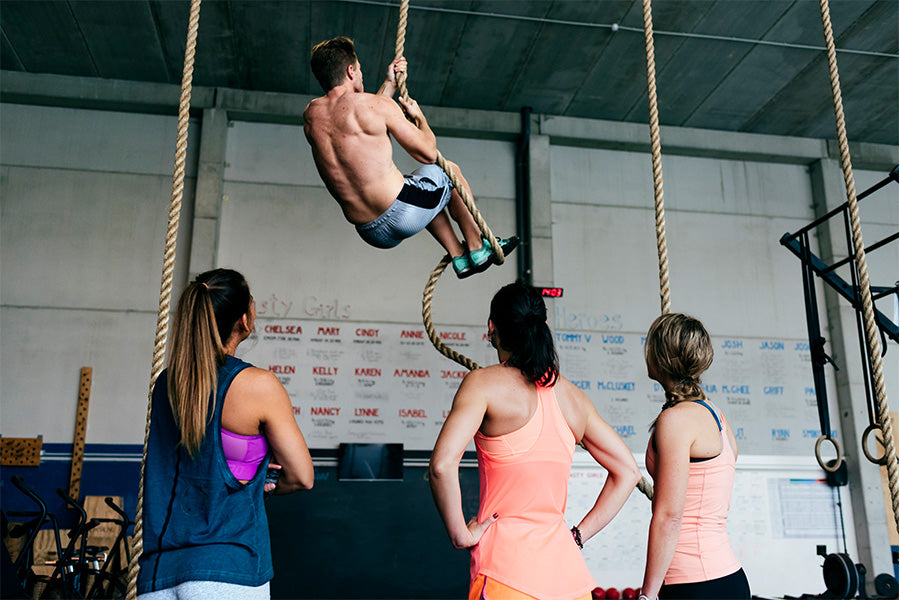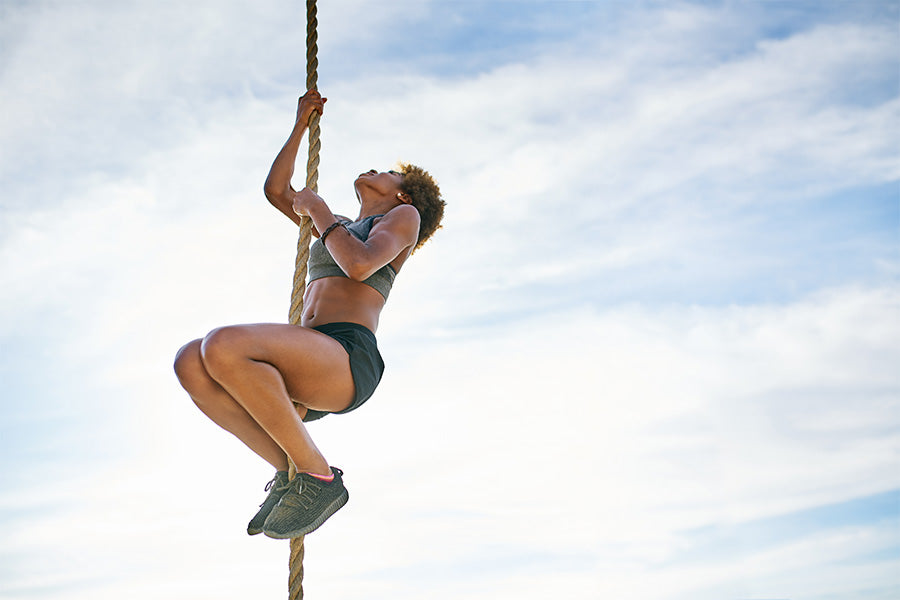For the fitness enthusiast looking for a new challenge, look no further than the rope climb. A gym staple, the rope climb is a full-body workout that works everything from your arms and shoulders to your abs and quads.
While it might look daunting at first, with a bit of practice, everyone can learn how to do a rope climb. Here's everything you need to know about rope climbing, from how to do it to all the different variations you can try.
How to Do Rope Climbs
For the uninitiated, rope climbs may seem like a daunting task. After all, what could be more intimidating than trying to scale a giant rope? However, rope climbing can be easy and even fun with a little practice! Here are a few steps to help you get started:
First, make sure that you have the right equipment. A climbing rope should be made of durable materials like nylon or polyester and have an appropriate length. You'll also need a pair of climbing shoes with a good grip.
Next, find a spot to climb. If you're indoors, look for a gym with a roped climbing wall. If you're outdoors, find a tree or other object that you can use to anchor the rope.
Once you've found your spot, it's time to start climbing. Start by wrapping the rope around your waist and holding onto the end with both hands. Then, place your foot in the rope loop and pull yourself up. Remember to keep your hands together and your body straight as you climb.
There are 4 steps to reach the top, including:
- Reach
- Lift
- Clamp
- Stand
Here’s a little detail of each step:
Reach
It will take a very long time to reach the top of the rope if you just make it a few inches each time. So, reach your arms as high as you can and ensure you are pulling yourself up with the fewest number of pulls possible to climb the rope more effectively.
Athletes can raise their arms nearly entirely overhead before locking them out. You should extend your arm before grabbing the rope with both hands.
Lift
Lifting comes next. Try lifting your knees as close to your chest as possible to get your feet high up the rope. Here, you may feel like grasping onto the rope for life, but don't worry because the next step comes right after it to secure your position.
Clamp
It's time to clamp the rope after your knees are brought up to your chest, not to squeeze or wrap it. One foot should be placed on top of the other to do this. You may grasp onto the rope very securely.
Stand
This last step is the simplest of the four, which will likely come as a relief to you. You just need to get up. Although it's not relatively easy, there isn't much more to it. Step up while keeping your hands in that extended stance. Pull your reach down to around chest level as you stand.
Variations of Rope Climbs
Rope climbs are a great way to get a full-body workout. But if you're bored with the traditional version, there are plenty of variations to keep things interesting. Here are a few of them:
Pull-Ups

Pull-ups are great for your back and shoulders. They work all the major muscles in your upper body, including your lats, traps, and rotator cuff. And because they're a compound exercise (meaning they work multiple joints and muscles simultaneously), they're fab for building strength and definition.
But, that's not all! Pull-ups also help improve your posture by lengthening your torso and pulling your shoulder blades down and back. Plus, they can enhance your grip strength (handy for when you're trying to open that jar of pickles) and boost your coordination.
You can follow these steps to execute a pull-up exercise properly:
- Hold the pull-up bar with a strong overhand grip. The distance between your hands and shoulder width should be a little wider.
- Hang with your arms fully extended from the bar.
- If your legs are still on the ground, fold them.
- Hold the motion for a minimum of 10 seconds.
- Now, flex your elbows while pulling your body upward while maintaining a strong core and back.
- When your chin is above the bar, slowly raise it.
- Slowly lower yourself while maintaining your breath.
Foot-Assisted Climb

The foot-assisted climb may seem like a godsend for anyone who's ever struggled to pull themselves up a rope. The technique is simple: instead of wrapping your arms around the rope, you place one foot on the rope and use your leg muscles to propel yourself upward.
The benefits are obvious - with your legs doing most of the work, your arms don't get as tired, and you can climb for longer. But it also has some hidden benefits. You engage more of your body in the climb by using your legs more, which can help improve your balance and coordination.
Additionally, using your feet provides a natural counterweight to your upper body, making it easier to control your movements. As a result, the foot-assisted climb can help you become a better, more efficient climber.
Bent Knee Horizontal Climb

The bent knee horizontal climb is a rope-climbing technique used by rock climbers and mountaineers. It is also known as the "death slide" because it can be fatal if not done correctly.
The climb entails attaching a rope to a large rock or tree and then sliding down the rope while keeping your body horizontal to the ground. This technique is often used when there is no other way to reach the top of a climb, but it can also be used to descend from a height.
It can be dangerous because it puts all your body weight on your hands and knees, which may lead to joint damage or even death if you slip. It is essential to be very careful when using this technique and to ensure that you are properly secured before climbing.
Here are the proper steps to follow:
- Start in a standing position, and grab the rope.
- Slowly start to lean back and lower yourself on the rope simultaneously.
- Bend your knees as you lower yourself down to offload some of your weight.
- Lower yourself to the ground before climbing back up to the standing position.
- That's one repetition. Repeat as necessary
Straight Leg Horizontal Climb

The straight-leg horizontal climb is a challenging variation of the regular rope climb. As the name suggests, this move requires the climber to keep their legs straight as they pull up the rope. It places a greater emphasis on the arms and shoulders, making it an excellent way to build upper-body strength.
It can also be used as a conditioning exercise, as it requires a great deal of endurance to complete. This move is an impressive feat of strength and stamina when performed correctly.
However, it should only be attempted by experienced climbers, as the added difficulty can make it easy to lose your grip and fall. However, you can use ventilated hand grips to minimize this.
Here’s how to do it:
- Start in a standing position and grab the rope.
- Slowly start to lean back and lower yourself on the rope simultaneously.
- Keep your legs straight as you lower yourself down.
- Lower yourself to the ground before climbing back up to a standing position.
- That's one repetition. Repeat as necessary.
Related Article: How to Strengthen Your Shoulders and Get the Muscles You Want
Row and Switch

There's nothing like the feeling of climbing to the top of a rope, especially if you've just mastered the row and switch. This challenging move requires coordination, strength, and timing, but once you get the hang of it, it's sure to be one of your favorite rope-climbing tricks. Here's how it's done:
- Start in a standing position, grab the rope with your right hand overtop of your left.
- Let yourself fall back using just your arm to hold your weight. You will still have your heels on the ground.
- Hold this position for a desired amount of time before pulling yourself back up to standing position.
- Repeat this except with your left hand overtop of your right hand.
It may sound complicated, but you'll be able to row and switch like a pro with some practice and dedication!
Benefits
Climbing rope is a great exercise. It builds strength, stamina, and coordination. It's also a lot of fun. And it turns out there are some other benefits of rope climbing that you may not have considered.
Helps Build Confidence
Getting to the top of a rope can be a real challenge- physically and mentally. But the accomplishment you get from reaching the top is worth it. And it's not just because you feel like you can conquer anything after rope climbing.
Rope climbing helps build confidence because it requires problem-solving, determination, and focus. You're building strength in those areas every time you overcome the obstacles and make it to the top of the rope.
Not only does rope climbing give you an excellent upper-body workout, but it also helps build the confidence that comes from overcoming challenges. So, next time you're feeling doubtful, remember that climbing a rope is always an option.
Offers a Full-Body Workout
Rope climbing is often seen as a fun childhood activity or a challenging test of athletic ability. However, rope climbing can offer a full-body workout with numerous health benefits.
Pulling oneself up the rope uses muscles in the arms, shoulders, and back, providing an excellent upper body workout. Additionally, stabilizing the body on the rope engages the core muscles, resulting in a more toned midsection.
And finally, the leg muscles are used to push against the rope, resulting in stronger and more defined legs. In short, rope climbing is a great way to get a full-body workout that can improve strength, endurance, and coordination.
Aids in Burning Fat
Burning fat. It's the ultimate goal, whether you're prepping for a marathon or just trying to slim down for swimsuit season. And there's no shortage of advice on how to do it. But here's something you may not have heard before: rope climbing can be an effective fat-burning exercise.
That's right, forget the treadmill and head to the nearest jungle gym instead. Of course, we're not talking about leisurely climbs here. You'll need to put some serious effort into seeing results.
But if you're up for the challenge, you'll be rewarded with an intense and fun workout. And who knows, you may even find yourself scaling new heights.
Related Article: Spring Shred: 12 Week Fat and Muscle Burning Workout Program
Improves Balance and Coordination
If you're looking for a way to improve your balance and coordination, rope climbing is a great option. It may seem like a simple activity, but climbing a rope requires a lot of coordination.
You must use your arms and legs to move the rope while keeping your balance. It can be a challenging workout for your entire body. Plus, it's a lot of fun! Few things are more satisfying than reaching the top of a rope and looking down at the ground below.
If you're looking for a way to improve your fitness, rope climbing is a great option. It's an excellent workout for your whole body and can help you develop coordination and balance. So next time you're at the gym, give rope climbing a try! You might be surprised at how challenging and fun it is.
FAQs
1. How many types of indoor rope climbing are there?
The first type of indoor climbing is top roping, where you place your hands on an already set-up rope. It can be done at any point during its length, but it's most secure when the bottom part threading through an anchor sits right next to where someone will climb up from below (think about how we hang our jackets).
The second type involves lead swinging which uses longer threads with lots more potential for movement before they reach their final destination; this style may not work well if there aren't enough pillows around!
2. Which exercise is best for rope climbing?
Different climbers may prefer different exercises, depending on their strengths and weaknesses. Some good exercises to try include pull-ups, deadlifts, and squats.
3. How do you simulate a rope climb?
There are a few ways to simulate a rope climb. One way is to use a pull-up bar and attach a rope.
4. What muscles are used in rope climbing?
The muscles used in a rope climb are the latissimus dorsi, trapezius, biceps brachii, and forearm muscles.
Wrapping It Up!
So there you have it – a comprehensive guide on how to do rope climbs. Start slowly, build up your strength and practice more often before attempting more advanced variations. And most importantly, have fun with it. All these variations offer multiple benefits, such as it helps build confidence, burn fat and lose weight, improve balance and coordination, and act as a full-body workout. So, if you want to include rope climbing in your fitness regime, don't delay. Try now!











